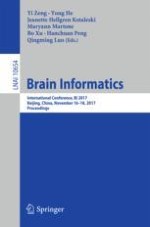2017 | Buch
Brain Informatics
International Conference, BI 2017, Beijing, China, November 16-18, 2017, Proceedings
herausgegeben von: Prof. Yi Zeng, Univ.-Prof. Yong He, Jeanette Hellgren Kotaleski, Dr. Maryann Martone, Bo Xu, Prof. Dr. Hanchuan Peng, Qingming Luo
Verlag: Springer International Publishing
Buchreihe : Lecture Notes in Computer Science
